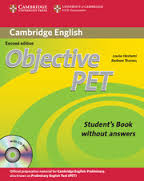Objective PET (CEF level B1)

This second edition of Objective PET is a revised and updated version of a course to prepare B1 students (adults and young adults) for the Cambridge Preliminary English Test (PET). It consists of a student’s book with or without key and CD-ROM, a workbook with key with or without answers, a teacher’s book, and three class audio CDs.
The coursebook is divided into 30 units, so it is suitable for short courses (70 hours) like mine, because there is enough time to cover all the topics and fit in exam practice as well. I especially like the way in which the units are structured. They open with a lead-in vocabulary activity, usually pictures that can be used as a test to check students’ previous knowledge and to practice photograph description. This is followed by either a listening or a reading activity which works on exam training and introduces the language focus. The grammar points are presented through guided discovery and students have to complete the Grammar Spot to check if they have understood the meaning and form. In this way, students themselves work out the grammar rules deductively. Students also find the Corpus Spots, which point out mistakes made by PET students, extremely useful, for student language awareness is honed by the process of correction. At the end of each unit, there is an Exam folder that gives the opportunity to see each exam task in depth with very practical exam advice.
The book comes with a CD-ROM, which offers extra practice for students and includes a complete PET test with audio. In addition, it contains wordlists downloadable as .pdf and as Excel (by unit, with definitions in English and translation) and handy teaching tips. In fact, I have used some of the matching activities as a vocabulary review test and as a warmer in my lessons. The disadvantage that I see as a Mac user is that it is only Windows compatible.
The workbook provides two further pages of practice for each unit and includes a complete key. It contains a variety of exercises which consolidate learning besides giving extra exams skills training. It can be used for self-study or in the classroom.
And then there is, naturally, the teacher’s book. Apart from the usual answers and notes on individual units, it consists of the following additional material: photocopiable activities, progress tests, photocopiable recording scripts, and sample answers for the writing folders. I find it is helpful to look at the scripts (with my students) in order to identify where the ‘distractors’ are or the cues that signal the answer is coming. In the same way, I ask my students to look for synonyms or similar phrases to the ones in the listening. The sample answers prove invaluable to students, who, by both comparing their answers to the models and marking the models themselves, become familiar with the requirements of the writing component of the exam. Besides, there is the website www.cambridge.org/elt/objectivepet where you can find additional material. I would particularly recommend the interactive game (vocabulary trainer) to practise vocabulary in an engaging way.
In conclusion, Objective PET, as CUP claims, is a “lively course” that provides everything necessary to “guide students towards success” – their words, with which I couldn’t agree more.
Ruth Castanera
